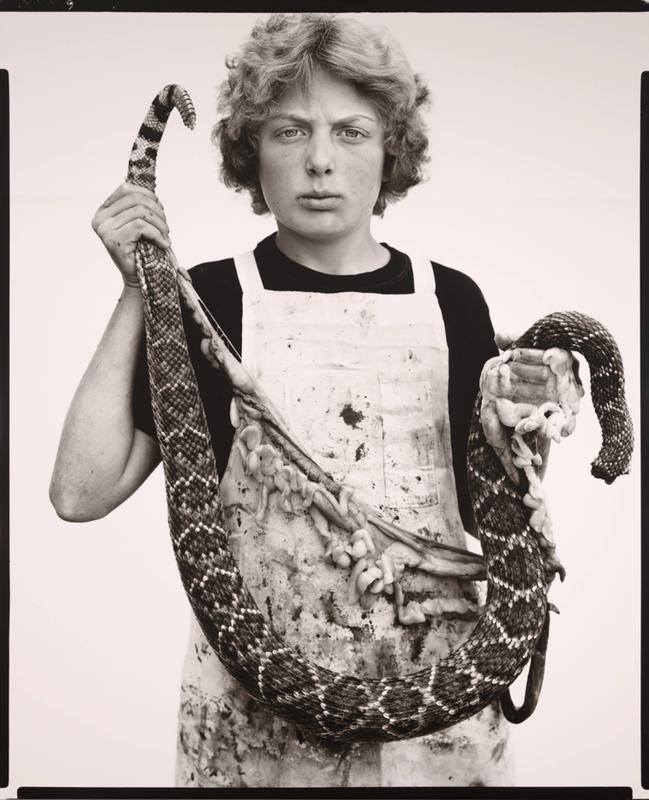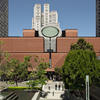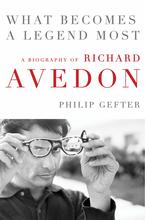More about Boyd Fortin, Thirteen Year Old Rattlesnake Skinner, Sweetwater, TX, March 10, 1979
- All
- Info
- Shop

Contributor
In pep talks with his four-person crew traversing the West, in a Suburban with equipment packed in the back, Avedon gave a key to his specific strategy in capturing Boyd Fortin.
He said, "I'm looking for people who are surprising—heartbreaking—or beautiful in a terrifying way." It can be terrifying, if you live in a big, coastal city, for example, give your surplus dough to PETA, and buy vegan yogurt, to admit that you find beauty in the countenance of this young snake hunter proudly displaying rattlesnake intestines. The image perhaps raises the distinct possibility that your differences of principle and geography do not make an absolute separation between the two of you. The above Avedon quote is recorded by Laura Wilson, mother of the actors Andrew, Luke, and Owen. Wilson also wrote the text for "In the American West," the book in which this photo, with the support of the Amon Carter Museum, debuted. This kind of beauty is much deeper than the aesthetic pleasantness that you might expect from the art word. It reveals one of the many hidden connections between Avedon's epochal work and the work of his collaborators, like James Baldwin, with whom Avedon worked in high school, and again later on their book, "Nothing Personal." The theme of Baldwin's text in that book is self-reflection, literally and metaphorically. Avedon and Baldwin worked over the idea together, and Avedon specifically emphasized challenging idea of beauty, which couldn't be fully separated from ugliness or that which scares you, "until you acknowledge it as part of yourself."
Like Andy Warhol's, the bulk of Avedon's work is inherently collaborative. In his early days in New York, Avedon used his family's Kodak Box Brownie camera, which your grandparents may remember with the fondness of an old friend. By the time he hired Wilson as a researcher, he needed someone to load the film, someone else to adjust the aperture and manage the models, and someone else—Wilson, in this case—to do the writing. When she met Avedon, Wilson noticed his strong personality, his "gravitational field," his "buoyant, inquisitive…visceral intelligence." She also notes his slight figure, his "olive skin" and dark features that made the first-generation Russian immigrant stand out in a place like Sweetwater. Most of all she noticed the focus and intensity which accompanied his "conspiratorial approach."
Already enormously famous for almost thirty years, Avedon could have insisted that his staff and models call him "His Eminence," or even "Richard," but, to them, he was "Dick," just a working-class dude from New York City. Rather than jumping at the newest technology, Avedon shot this picture with a vintage-style 8x10 Deardorff view camera, which had been on the market for nearly thirty years, as if to remind himself not to take his success for granted. The 8x10 Deardorff looks beautiful, hasn't been in production for at least thirty years, and it's not easy to find one in good condition for the price of your rent. Once you set up the shot, you can pull your head from the womb-like black viewfinder shroud and stare into your model's eyes like Dick Avedon while you capture the shot. This is one of the components in Dick Avedon's "conspiratorial approach," which aids him in infiltrating the lives of everyday people to capture them at their most honest.
Ultimately, according to a Chicago Tribune interview with Boyd Fortin's mother from a couple of years after Avedon and his crew finished their seven-summer sojourn in the West, this work was a great help to Fortin, making him, in the eyes of his small-town neighbors, a "hometown kid who made good," and he eventually enrolled in medical school at Southwest Texas State University in San Marcos. In this image, Fortin is holding the remains of a Western diamondback, whose Latin name is Crotalus atrox.
Sources
- "Boyd Fortin, Thirteen Year Old Rattlesnake Skinner, Sweetwater, Texas, March 10, 1979 by Richard Avedon." Writing Visual Culture, Feb. 14, 2014, https://ucart100.wordpress.com/2014/02/14/boyd-fortin-thirteen-year-old…
- Foerstner, Abigail. "RICHARD AVEDON FASHIONS A PORTRAIT OF AMERICAN WEST." Chicago Tribune, May 23, 1986, https://www.chicagotribune.com/news/ct-xpm-1986-05-23-8602070025-story,….
- Henderson, Carol E. James Baldwin's Go Tell it on the Mountain: Historical and Critical Essays. New York: Peter Lang, 2006.
- Hough, Ken. "The Deardorff View Camera," WebCite, https://www.webcitation.org/query?url=http://www.geocities.com/eureka/p….
- Munson, David R. "The Deardorff 8x10 Field Camera," Large Format Page, https://www.largeformatphotography.info/deardorff-8x10/.
- Wilson, Laura. Avedon at Work: In the American West. Austin: University of Texas Press, 2003.
- Wilson, Laura. "What I learned from Richard Avedon." Variety, Mar. 27, 2008, https://variety.com/2008/biz/markets-festivals/what-i-learned-from-rich….












